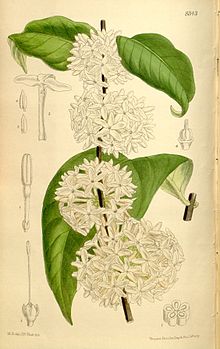Pleiocarpa mutica
Appearance
| Pleiocarpa mutica | |
|---|---|

| |
| Pleiocarpa mutica [1] | |
| Scientific classification | |
| Kingdom: | Plantae |
| Clade: | Tracheophytes |
| Clade: | Angiosperms |
| Clade: | Eudicots |
| Clade: | Asterids |
| Order: | Gentianales |
| Family: | Apocynaceae |
| Genus: | Pleiocarpa |
| Species: | P. mutica
|
| Binomial name | |
| Pleiocarpa mutica | |
| Synonyms[3] | |
| |
Pleiocarpa mutica is a plant in the family Apocynaceae.
Description
Pleiocarpa mutica grows as a shrub or small tree up to 7.5 metres (25 ft) tall, with a stem diameter of up to 5 cm (2 in). Its fragrant flowers feature a white
corolla. The fruit is yellow to bright orange with paired follicles, each up to 2 cm (1 in) long. Local medicinal uses include as a treatment for stomach-ache, kidney diseases, malaria, jaundice and as a laxative.[4]
Distribution and habitat
Pleiocarpa mutica is native to an area of tropical Africa from Sierra Leone east to the Central African Republic.[3] The species is found in a variety of habitats from sea-level to 600 metres (2,000 ft) altitude.[4]
Phytochemistry
The alkaloid kopsinine, which has in vitro anticholinergic activity, has been isolated from Pleiocarpa mutica.[5]
References
Wikimedia Commons has media related to Pleiocarpa mutica.
- ^ 1910 illustration from M.S. del., J.N.Fitch lith. - Curtis's Botanical Magazine, London., vol. 136 [= ser. 4, vol. 6]: Tab. 8343
- . Retrieved 20 November 2021.
- ^ a b c "Pleiocarpa mutica". Plants of the World Online. Royal Botanic Gardens, Kew. Retrieved 30 August 2020.
- ^ ISBN 978-9-05782-204-9.
- PMID 23720886.

